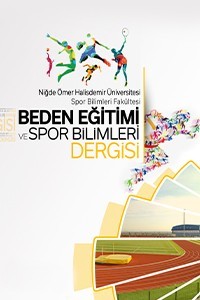RAFTİNG KATILIMCILARININ RAFTİNG KAVRAMINA İLİŞKİN METAFORİK ALGILARI
Metafor, rafting, nitel araştırma
RAFTING PARTICIPANTS’ METAPHORIC PERCEPTIONS CONCERNING THE CONCEPT OF RAFTING
Metaphor, rafting, qualitative research,
___
- 1. Alger C. Secondary Teachers' Conceptual Metaphors of Teaching and Learning: Changes Over The Career Span. Teaching and Teacher Education: An International Journal of Research and Studies, 2009; 25 (5): 743-751.
- 2. Arslan MM. ve Bayrakçı M. Metaforik Düşünme ve Öğrenme Yaklaşımının Eğitim-Öğretim Açısından İncelenmesi. Milli Eğitim, 2006; 35(171): 100-108.
- 3. Aydın F. ve Ünaldı ÜE. The Analysis of Geography Teacher Candidates’ Perceptions towards “Geography” Concept with the Help of Metaphors, International Online Journal of Educational Sciences, 2010; 2(2): 600-622.
- 4. Botha E. Why metaphor matters in education. South African of Education, 2009; 29: 431-444.
- 5. Çapan EB. Teacher Candidates’ Metaphoric Perceptions Of Gifted Students, The Journal of International Social Research, 2010; 3(12): 140- 154.
- 6. Çoşkun M. Metaphors (Mental Images) of High School Students About “Climate” Concept, International Periodical for the Languages, Literature and History of Turkish or Turkic, 2010; 5(3): 919-940.
- 7. Cerit Y. Öğretmen Kavramı İle İlgili Metaforlara İlişkin Öğrenci, Öğretmen Ve Yöneticilerin Görüşleri. Türk Eğitim Bilimleri Dergisi, 2008; 6(4); 693-712.
- 8. Döş İ. Metaphoric Perceptions of Candidate Teachers to the Concept of Inspectors, University of Gaziantep Journal of Social Sciences, 2010; 9(3): 607-629.
- 9. Forceville C. The Identification of Target and Source in Pictorial Metaphors. Journal of Pragmatics, 2002; 34: 1-14.
- 10. Gillis C, Johnson CL. Metaphor as Renewal: ReImagining our Professional Selves. English Journal, 2002; 91(6): 37–43.
- 11. Guerrero MCM, Villamil OS. Metaphorical Conceptualizations of ELS Teaching and Learning. Language Teaching Research, 2002; 6(2): 95-120.
- 12. Kaya H. The Analysis of Secondary Education Students’ Perceptions Towards “The World” Concept. World Applied Sciences Journal, 2011; 12(2): 190-196.
- 13. Lakoff G, Johnson M. Metaforlar: Hayat, Anlam ve Dil (Çeviren: G.Y. Demir), Paradigma,İstanbul, 2005.
- 14. Levine PM. Metaphors and Images of Classrooms, Kappa delta Pi Record, 2005; 41(4); 172-175.
- 15. Miles MB, Huberman AM. Qualitative Data Analysis. Thousand Oaks, CA: Sage. 1994.
- 16. Öztürk Ç. Metaphor Status about The Concept of ‘Geography’ of Prospective Social Science, Science and Classroom Teachers, Ahi Evran Üniversitesi, Kırşehir Eğitim Fakültesi Dergisi, 2007; 8(2): 55-69.
- 17. Saban A. Giriş Düzeyindeki Sınıf Öğretmeni Adaylarının “Öğretmen” Kavramına İlişkin İleri Sürdükleri Metaforlar. Türk Eğitim Bilimleri Dergisi, 2004; 2(2). 131-155.
- 18. Saban A. Primary School Teachers’ and Their Students’ Mental Images about the Concept of Knowledge, Elementary Education Online, 2008; 7 (2): 421-455.
- 19. Saban A. Öğretmen Adaylarının Öğrenci Kavramına İlişkin Sahip Olduğu Zihinsel İmgeler. Türk Eğitim Bilimleri Dergisi, 2009; 7(2): 281-326.
- 20. Saban A, Koçbeker BN. Saban A. Öğretmen Adaylarının Öğretmen Kavramına İlişkin Algılarının Metafor Analizi Yoluyla İncelenmesi. Kuram ve Uygulamada Eğitim Bilimleri, 2009; 6(2): 461-522.
- 21. Shaw D, Massengill B, Mahlios M. Preservice Teachers' Metaphors of Teaching in Relation to Literacy Beliefs. Teachers and Teaching: Theory and Practice, 2008; 14 (1): 35-50.
- 22. Töremen F, Döş İ. İlköğretim Öğretmenlerinin Müfettişlik Kavramına İlişkin Metaforik Algıları. Kuram ve Uygulamada Eğitim Bilimleri, 2009; 9(4): 1973-2012.
- 23. Weade R, Ernst G. Pictures of Life in Classrooms, and the Search for Metaphors to Frame Them. Theory into Practice, 1990; 29(2): 133–140.
- 24. Yıldırım A, Ünal A, Çelik M. The analysis of Principle’s, Supervisior’s and Teacher’s perception of the term “Teacher, International Journal of Human Sciences, 2011; 8(2): 92-109.
- 25. Yıldırım A, Şimşek H. Sosyal Bilimlerde Nitel Araştırma Yöntemleri, Seçkin Yayınevi, Ankara, 2006.
- 26. Yob IM. (2003). Thinking Constructively With Metaphors. Studies in Philosophy and Education, 2003; 22: 127-138
- ISSN: 1307-6477
- Yayın Aralığı: Yılda 3 Sayı
- Başlangıç: 2007
- Yayıncı: Niğde Ömer Halisdemir Üniversitesi
EFFECT OF GENDER DIFFERENCE AND CIRCADIAN RHYTHM ON TOTAL MOOD DISTURBANCE OF VOLLEYBALL PLAYERS
EGZERSİZE BAĞLI KAS HASARININ SÜRAT VE ÇEVİKLİK PERFORMANSINA ETKİSİ
Şengül AKDENİZ, Ümid KARLI, Tuğba DAŞDEMİR, Hakan YARAR, Bayram YILMAZ
Tülin ATAN, Pelin AKYOL, Osman İMAMOĞLU
TÜRK ANTRENÖRLERININ MESLEKI BENLIK SAYGISI DÜZEYLERININ İNCELENMESI
Yunus YILDIRIM, Hüseyin KIRIMOĞLU, Gülşen Fizlazoğlu ÇOKLUK
TÜM BEDEN VİBRASYON ANTRENMANININ NÖROFİZYOLOJİK ETKİLERİNİN İNCELENMESİ
BİREYSEL VE TAKIM SPORU YAPAN SPORCULARIN BAZI FİZİKSEL UYGUNLUK ÖZELLİKLERİNİN KARŞILAŞTIRILMASI
Mustafa Kayıhan ERBAŞ, Hüseyin ÜNLÜ
GENÇ ELIT GÜREŞÇILERIN FIZIKSEL VE FIZYOLOJIK ÖZELLIKLERININ KARŞILAŞTIRILMASI
Erkan DEMİRKAN, Rafet ÜNVER, Mehmet KUTLU, Mitat KOZ
RAFTİNG KATILIMCILARININ RAFTİNG KAVRAMINA İLİŞKİN METAFORİK ALGILARI
Erkan Faruk ŞİRİN, Fatih BEKTAŞ, Gülsen KARAMAN, Gonca Korucu AYTAN
